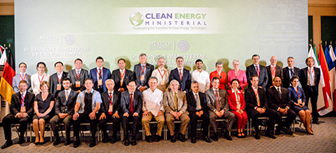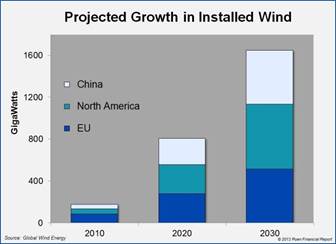Clean Energy Ministerial and World Bank to Help Countries Scale Up, Integrate Renewable Energy in Grids
MÉRIDA, MEXICO, May 27, 2015
The Clean Energy Ministerial (CEM) will work with the World Bank’s Energy Sector Management Assistance Program (ESMAP) to deliver targeted technical assistance that will help developing and middle-income countries integrate large shares of wind and solar energy into their electricity grids.
 The
price of wind and solar inputs has dropped substantially in recent years, and
these energy sources are becoming cost-competitive with coal and gas for
electricity generation in some markets. Over 144 countries have set
renewable energy targets, and more than 100 have already enacted policies or
measures to promote the use of renewables. Since 2011, over half of net
capacity additions in the global power sector have come from new renewable
energy deployment.
The
price of wind and solar inputs has dropped substantially in recent years, and
these energy sources are becoming cost-competitive with coal and gas for
electricity generation in some markets. Over 144 countries have set
renewable energy targets, and more than 100 have already enacted policies or
measures to promote the use of renewables. Since 2011, over half of net
capacity additions in the global power sector have come from new renewable
energy deployment.
However, the prospect of meeting a sizeable share of electricity demand through wind and solar also requires expansion and modernization of electricity grids, as well as significant changes to policies and operational practices. There is tremendous demand for technical assistance to help countries make the transition to a “renewable-friendly” grid.
CEM and the World Bank will work together to meet this demand by leveraging CEM’s wide-ranging technical expertise to support a new ESMAP initiative. The ESMAP Variable Renewable Energy Integration Program helps countries develop capacity for long-term grid planning, market design, renewable energy pricing, development of rules of access to electricity grids, and strengthening of the electricity dispatch and transport infrastructure.
Countries participating in this initiative will now have access to technical experts, knowledge and resources through CEM’s 21st Century Power Partnership (21CPP) and Clean Energy Solutions Center. The services provided will help countries address immediate issues and increase their capacity for longer-term policy and investment planning.
“Technical assistance is critical for developing the policies, targeted investments and infrastructure that make the transition to renewable-friendly grids possible,” said Anita Marangoly George, Senior Director of the World Bank’s Energy and Extractives Global Practice. “The World Bank and the Clean Energy Ministerial can bring together technical expertise, country engagement and financing to help facilitate this transition.”
Together, the ESMAP and CEM initiatives will work to deliver the most advanced knowledge—from technical integration of VRE and smart grids to harmonized policy and regulatory frameworks—that will draw from the experiences of vanguard countries already managing high percentages of wind and solar penetration. The Clean Energy Solutions Center will provide just-in-time technical assistance to policy makers participating in the ESMAP initiative through its “Ask-An-Expert” service.
Opportunities will also be identified to hold clean energy workshops and webinars to provide cooperative training for policy makers in participating countries. Additionally, ESMAP donors and the United States will support ESMAP by sending technical experts to play key roles in the Variable Renewable Energy Integration initiative.
”Accelerating clean energy deployment while maintaining reliability and affordability is an area of significant research and innovation in the United States and other countries around the world,” said Jonathan Elkind, Principal Assistant Secretary for International Affairs at the U.S. Department of Energy. “We are excited that through this partnership we can directly apply this knowledge to help other countries more effectively scale up their share of renewables."
This collaboration will expand the work of 21CPP on grid integration already underway through multi-year technical assistance programs in India, Mexico, and South Africa. The ESMAP initiative, although still in its early stages, is already evaluating proposals for support in Mexico, Guatemala, Costa Rica, Honduras, Haiti, Morocco, Ukraine, India, Philippines, Seychelles, South Africa and Vietnam.
The 21st Century Power Partnership is an initiative of the Clean Energy Ministerial focused on power sector transformation and grid integration of renewable energy, energy efficiency, and smart grid technologies. For more information and to view reports and publications, visit http://www.21stcenturypower.org/ or contact 21stcenturypower@nrel.gov.
The Clean Energy Solutions Center, an initiative of the Clean Energy Ministerial, provides no-cost policy assistance, training, and tools to help governments, advisors, and analysts create policies and programs that advance the deployment of clean energy technologies. The Solutions Center is co-led and co-funded by the U.S. Department of Energy through support from the U.S. Department of State and the Australian Department of Industry and Science. For more information, visit www.cleanenergysolutions.org.
The Energy Sector Management Assistance Program (ESMAP), a multi-donor technical assistance trust fund program administered by the World Bank, helps countries increase their knowledge and institutional capacity to achieve environmentally sustainable energy solutions for poverty reduction and economic growth. For more information, please visit www.esmap.org.

The world needs to triple its investments in clean energy innovation
By Chris Mooney, Washington Post May 4
The world needs to triple its investments in clean energy research, suggests a new study by the Paris-based International Energy Agency, if we’re to have a chance of keeping the world below 2 degrees Celsius of warming above pre-industrial levels — a level beyond which truly dangerous climate change might set in.
That’s because in addition to any international agreement to cut carbon emissions that may be reached at the end of this year, the world will also need new technologies to fill the gap left behind as we use less of fossil fuels like coal.
The new document, IEA’s Energy Technology Perspectives 2015, notes that land-based wind and solar photovoltaic in particular have grown markedly and are now “ready to be mainstreamed in many energy systems.” But there’s still a gap: We need innovation in discovering “enabling technologies” that can better integrate these inherently variable sources of energy (wind doesn’t always blow, sun doesn’t always shine) into our electrical systems.
According to the agency, while greater deployment of wind and solar could contribute to a dramatic 22% decline in total emissions from world electricity by the year 2050, “for very high deployment levels of wind and PV, innovation is needed in demand-side integration, energy storage and smart grid infrastructure.”
Energy storage technology in particular has been a
hot topic of late, thanks to the announcement by Tesla Motors of the creation
of Tesla Energy, which will sell battery products for homes, businesses, and
for power companies.
The new IEA report says that the cost of
lithium-ion batteries for energy storage at the scale of the electric grid had
declined to $600/kilowatt-hour as of 2013 — but if Tesla CEO Elon Musk is to be
believed, it is actually way lower than that already. Thus, energy storage
technology could be one area where innovation is actually charging ahead right
now.
But in general, IEA says, the world is not innovating fast enough. We need to be “decoupling” economic and population growth from energy use more than two times as rapidly as we currently are, it says.
 |